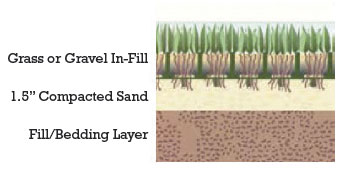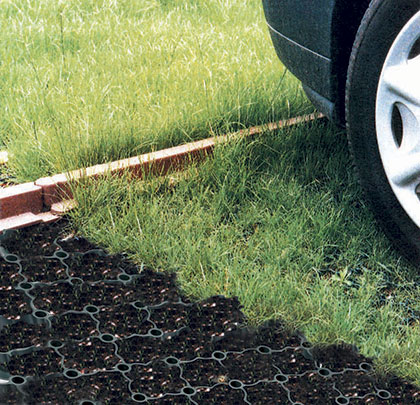In part 1 of this article, we noted that, in residential settings, drains that can act as a physical barrier to water provide an extra layer of protection against damage to homes. However, there is always a push to optimize drain design for improved function as well as aesthetics. One of the most innovative products when it comes to design aesthetics is the ACO Self HexaLine Brickslot slotted trench drain system, which provides effective, yet discreet, slot drainage in domestic paver or tile installation.
MINIMIZE PAVED AREAS
One of the clearest ways to improve water management in residential settings is to minimize the impact of the factors that call for management in the first place. One of these, as mentioned above, is pavement. More pavement means more drainage is necessary, as pavement is non-permeable and blocks stormwater from being absorbed into the ground. Reducing or eliminating pavement may be a clear water management solution; however, it isn’t an easy one, given the function pavement serves in accommodating vehicular and foot traffic. Because of this, innovative new water management technologies have been developed to help homeowners minimize the amount of pavement near their homes, without losing the functionality that the pavement usually serves.
Take, for example, the GrassGrid product. GrassGrid creates a stable surface that is simultaneously capable of supporting vehicles and allowing rainwater to be absorbed where it falls. This product, a modular plastic grid structure that allows for easy installation in any size or shaped area, is installed on a supporting bed of gravel and sand, much like a driveway. Unlike a driveway, however, the plastic grid of GrassGrid supports vehicles or foot traffic while covering only 10 percent of the ground at its surface. The other 90 percent of space is designed to be filled with soil and seeded with grass, or filled and covered by gravel. These covering options keep GrassGrid out of sight, while GrassGrid prevents erosion of the underlying materials.
GrassGrid is rated to withstand 28 tons per square foot, and so the load from vehicles and foot traffic is transferred through the grid into the sand and gravel bed without compacting the topsoil. The product design allows rainwater to be absorbed by the ground where it falls, thereby minimizing the impact on the natural water cycle and reducing the load on stormwater drains. With GrassGrid and other products that replace traditional hardscaping, vehicular and foot traffic can be accommodated while effectively managing stormwater.

Featured Image: GrassGrid offers a surface strong enough to withstand vehicles’ load, while allowing for easy water drainage.
Above: GrassGrid offers easy installation and an aesthetically pleasing alternative to pavement.
COLLECT STORMWATER FOR REUSE OR SLOW INFILTRATION INTO SOIL
Of course, even with the availability of products like GrassGrid, a significant amount of residential property is covered by non-permeable surfaces or roofed areas. Further efforts, therefore, must be made to reduce the load on storm drains and minimize the impact of development on the natural water cycle. Traditional water management systems rely heavily on municipal storm drains to handle stormwater runoff from roofs and paved areas during storm events. These drains, however, often flood, alter the natural water cycle, and are not available in all areas.
How, then, can residential water management systems better handle the runoff collected from non-porous or roofed areas? Over the last several years, ACO has been researching the use of underground stormwater management technology to minimize environmental impact of development and accompanying drainage systems while reducing the likelihood of flooding. The results of this research have been innovative products for both commercial and residential use.
ACO will introduce a residential Infiltration Line product to the market later this year that collects water and slowly releases it into the soil. Infiltration systems, also known as “dry wells” or “soakaways,” can mitigate the effects of drought by storing excess rainwater for release into the ground during dry periods. These systems also reduce the demand for water to maintain landscaping, saving costs, and solve drainage issues where there is no outlet pipe available.
IMPROVE COLLECTION, STORAGE, AND RELEASE
With the use of all of these groundbreaking water management technologies, it is possible for any construction company or contractor to greatly improve water collection, storage, and release on their customers’ residential properties. These technologies protect customers’ investment in their homes, while positively impacting the water cycle, reducing the likelihood of dangerous flooding, reducing the impacts of drought, and retaining landscape aesthetics. ◆
Dinu Filip is president of ACO Systems, Ltd. ACO Polymer Products, Inc. introduced the concept of modular trench drains to North America over thirty years ago. ACO specializes in the manufacture of drainage products utilizing polymer concrete, cast iron foundry and plastic extrusion. Today, ACO manufactures a range of drainage and landscape products from polymer concrete, stainless steel, mild steel, cast iron, fiberglass, and molded plastics. These diverse material types are used to produce components for all applications: commercial and residential construction, as well as electromechanical engineering and environmental protection. ACO USA is a part of the ACO Group, which employs more than 3800 people worldwide in forty countries, with production facilities in North America, Europe, China, and Australia. These resources, supplemented with a worldwide network of agents, make superior-quality ACO products available in every corner of the world.
____________________________________________
MODERN PUMPING TODAY, September 2015
Did you enjoy this article?
Subscribe to the FREE Digital Edition of Modern Pumping Today Magazine!
![]()


